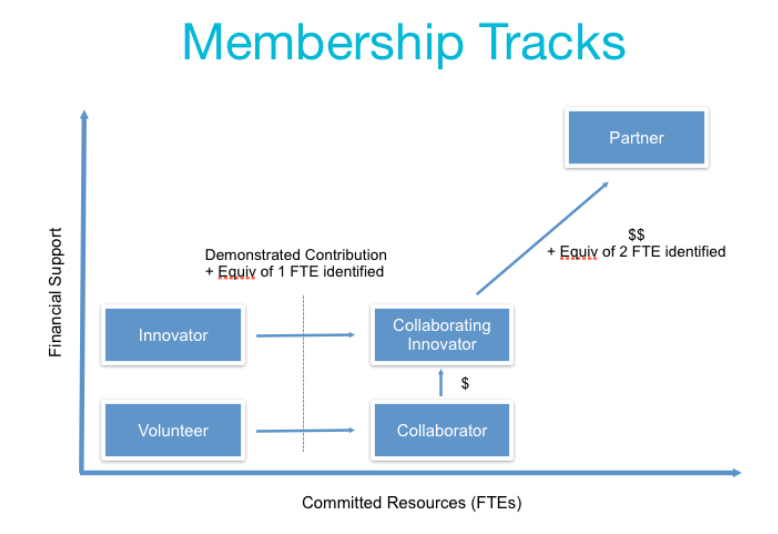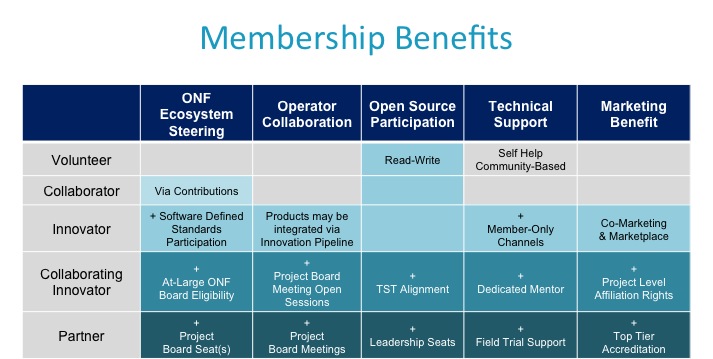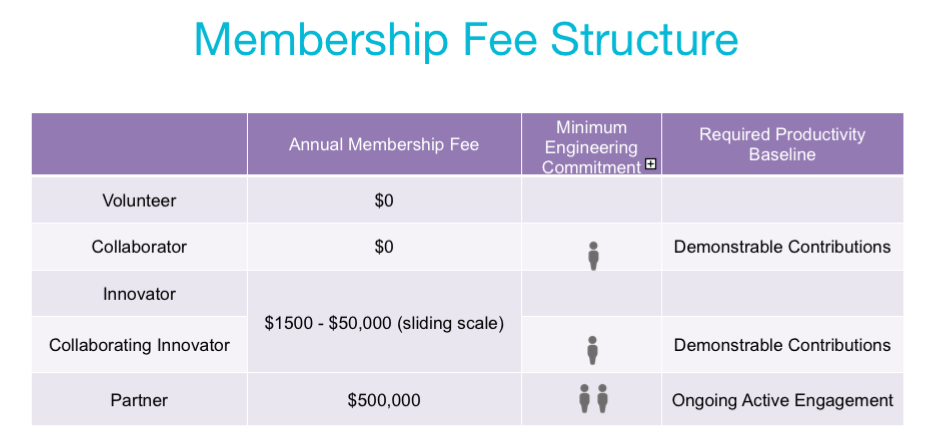As we complete the merger of ON.Lab and ONF, we are contemplating a reworked membership structure to suit the needs of all members of our community. We’d like your feedback on what we are considering.
The CORD and ONOS projects have had a membership structure that recognizes collaborating organizations and a select number of partners that have provided financial support, technical contributions and valuable guidance and steering. The legacy ONF has had a much broader membership base, with financial support and contributions coming from all members of the organization in a more uniform way.
With the merger, there is a need to combine these two membership structures and we wanted to share our thoughts about how this can be done. As you’ll see, in addition to combining structures we’ve also added a new membership level that will help us better recognize and support contributing organizations.
Proposal for new Membership Structure
The proposed new membership structure is outlined below. Let’s start by comparing the levels. This first graphic puts the different membership levels in context and show how they are arranged according to the commitment of an organization’s time and skills and/or financial commitment. It also shows how organizations can strengthen their commitment over time by progressing upgrading the levels.

Each membership level comes with a number of specific benefits. This next chart describes the benefits in an additive way. That is, as you move down the rows of the chart you are also entitled to all the benefits from the rows above.

Each level requires certain commitments from members, typically a combination of financial support, engineering resources and demonstrated contributions to the community.

To make it easy to understand, we’ll highlight some of the main points.
For Collaborators - we’ve seen tremendous growth. We’re modestly adjusting this level to accommodate our increased size and to optimize our working model. Similar to how things are today, if an organization wants to contribute their time and skills (minimum of the equivalent of 1 full-time engineer (FTE)), but not make a financial contribution, we welcome them as collaborators and want to do our part to make them productive members of the ecosystem. There will, however, be some changes:
- In the past, TST approval on a project proposal was sufficient to achieve Collaborator status. Rather than up front approval, a demonstrated deliverable would now be the measure for gaining access to this class of membership.
- Because the core development team has limits on their time, we can’t guarantee that collaborators will receive a certain level of support beyond what they can find from community resources (wiki, mailing list, Slack, etc).
- Similarly because we have limits on our marketing resources (and marketing is expensive) we are moving marketing benefits into the paid tiers of membership.
We believe there would still be great value in being a Collaborator. By contributing to our projects, Collaborators can continue to influence the direction of our efforts and merge in features and capabilities beneficial to their goals. And as before, if organizations stop contributing, their Collaborator status can be lost due to inactivity.
For Innovators (default entry point for legacy ONF members):
We’ve split this tier into two to reflect the type of contributions organizations are interested in making. Some organizations want to support us financially but don’t have the ability to contribute significant time and skills. The revised Innovator tier recognizes these organizations and tries to minimize barriers to entry by offering a revised fee structure based on a sliding scale according to company size, with the lowest level being $1500 a year for the smallest organizations.
For Collaborating Innovators:
We want to recognize those organizations that are able to contribute both financially and with time and skills. We’ve also provided a host of new benefits and engagement opportunities to encourage more organizations to consider this option, including a chance to run for an at-large board seat, a dedicated mentor who will provide technical support/steering and new marketing and branding opportunities.
Innovators who have demonstrated a commitment to our work (with a minimum of one named FTE dedicated to working with us) and who have a record of providing significant contributions can petition to be upgraded to this category.
For Partners:
This level remains as it has been. Partners have a shared vision and mission with the ONF and are looking for very close alignment around strategy, execution and support. They make significant financial and resource contributions to help us drive our shared agenda forward. And of course they derive the greatest benefits in terms of ability to:
- Steer and influence the entire ecosystem,
- Leverage the open source platforms and solutions for transforming their businesses, and
- Transform their workforce and culture through active engagement in our work.
And lastly, the sliding scale. We are contemplating adjusting membership fees for the Innovator and Collaborating Innovator tiers to ensure the financial burden is more reasonably sized to an organization’s ability to support our shared mission. In the past, the legacy ONF had a single tier as well as ‘startup memberships’ that were only available to companies under four years of age. Recognizing that not all companies grow at the same rate, and that there are valuable members of our community that may never grow large (like consulting companies), we’re contemplating completely revamping the financial tiers based on company revenue.

We are very interested in your thoughts on this. Note – this isn’t set in stone yet, so there is still time to provide comments, questions and suggestions for how to make this recognition system work better for all members of our community. Please send us your thoughts, and when we’ve collected input we’ll update our plans and share a final version.
Thanks for your continued support,
Timon
VP Standards & Membership, ONF
Timon at opennetworking.org

